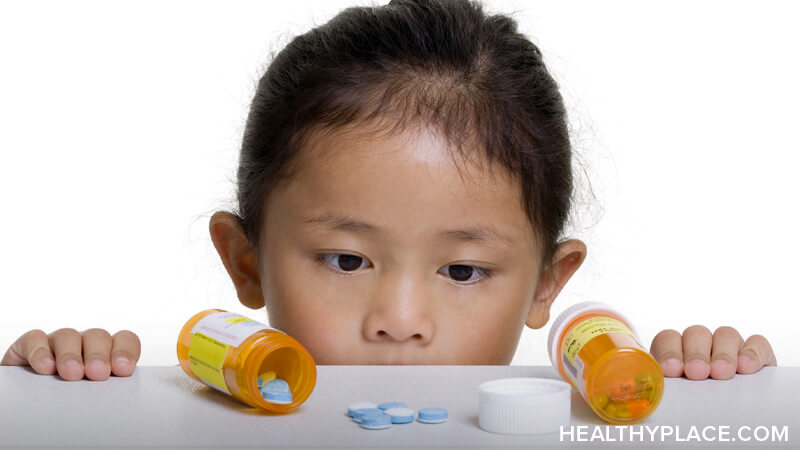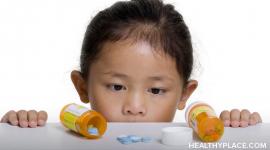Guide to Psychiatric Medications for Children and Adolescents

Descriptions of psychiatric medications for treating child and adolescent psychiatric disorders; including benefits and side-effects.
The information below includes most of the medications used to treat child and adolescent psychiatric disorders. You will find the problems each medication might treat and some of the common side effects. This guide is intended to be informative and useful, but it is not comprehensive. Children should take these medications only under the careful supervision of their physicians.
Listed are only those adverse effects that occur more commonly and those that are rare but potentially serious. Always alert your physician about any other medications, over the counter pill and 'alternative treatments' that you may be taking.
Classes* of Psychiatric Medications:
|
|
*The class of a medication is often a useful way of grouping similar medications. However, there is no particular format or rule for this and therefore the class name is somewhat arbitrary. The name can signify it most common use (many of these medications can treat more than one disorder), its mechanism of action or rarely some side-effect.
The brand name of a medication is the name a company will use to sell its unique formulation of a medication. When a drug is first developed it will have two names. The first is the name which describes its chemical structure but is never used outside the laboratory. The second is what will be its generic name. This name will be used until the medication is approved by the FDA and ready to be sold to the public. Once the medication is ready for sale it will be given a brand name. After the patent expires other companies will be allowed to make the medication and it will generally be sold under the generic name. (The following example will illustrate the various names for a single medication. See if you can guess what the medication is from its chemical name: N-Methyl--[4-(trifluoromethyl)phenoxy]benzenepropanamine, Not sure? Its generic name is fluoxetine. Still not sure? The brand name is Prozac.
Class: Stimulants
| Benefits: Treats the core symptoms of Attention-Deficit/Hyperactivity Disorder (ADHD) including, impulsivity, hyperactivity and inattention. There is very little documented difference in the effectiveness between the amphetamine and methylphenidate medicines. However, some children respond to one group better than another.
Side Effects: Loss of appetite, difficulty falling asleep, irritability and /or moodiness. Some children may develop tics while on the medicine while those with a tic disorder may find that the tics worsen. Both growth and weight should be monitored, since weight loss can occur, and there is some evidence that stimulants may cause a slowdown in growth. Very rarely they may cause hallucinations or exacerbate manic symptoms These medications can increase blood pressure and pulse slightly. Please tell your doctor if there are any relatives with a history of heart disease at an early age. |
||
| MEDICATION NAME | NOTES | |
| Brand Name | Generic Name | |
| Ritalin Focalin Methylin Methylin Chewable Methylin Liquid |
methylphenidate | These are short acting—generally lasting about 3-4 hours. |
| Concerta Focalin XR Metadate CD Ritalin LA Daytrana Patch |
methylphenidate | These are long acting—generally lasting about 8-12 hours. Each one is formulated somewhat differently but there is generally no way to determine which will last the longest for any individual. Daytrana is the newest and uses a patch to deliver methylphenidate through the skin. The patch may cause some skin irritation. |
| Dexedrine Dextrostat Adderall |
amphetamine | These are short acting—generally lasting about 3-6 hours. Each one is formulated somewhat differently but there is generally no way to determine which will last the longest for any individual. Adderall is a mixture of different forms of amphetamine (amphetamine salts). |
| Adderall XR | amphetamine salts | Lasts 8-10 hours |
| Dexedrine Spansules | amphetamine |
Lasts 8-10 hours |
CLASS: Non-Stimulant (Selective Norepinephrine Reuptake Inhibitor)
| Benefits: Treats the core symptoms of ADHD. May not have as robust an effect on symptoms as the stimulants but may help individuals who have anxiety along with their ADHD.
Side Effects: Decreased appetite, nausea, insomnia or tiredness, dry mouth. |
||
| MEDICATION NAME | NOTES | |
| Brand Name | Generic Name | |
| Strattera | atomoxetine | Has the potential to last 24 hours. Can often be given just once a day although some patients require a second dose in the late afternoon. Unlike most medications this one is dosed based upon the patient's weight. |
CLASS: Antihypertensive
| Benefits: Historically used for the control of high blood pressure. Often used as a first medical treatment for the tics of Tourette Disorder. Can be useful in treating the hyperactive and impulsive symptoms of ADHD. Can sometimes help with children who have aggressive behaviors. Generally not useful for the inattentive symptoms.
Side Effects: Dry mouth, sedation, dizziness. Rarely can trigger depressive symptoms. |
||
| MEDICATION NAME | NOTES | |
| Brand Name | Generic Name | |
| Tenex | guanfacine | The TTS is a patch that is changed every 3-4 days. It may cause local irritation. |
| Catapres, Catapres TTS patch | clonidine | |
CLASS: SSRIs or SRIs (specific serotonin reuptake inhibitors)
| Benefits: Historically used for the control of high blood pressure. Often used as a first medical treatment for the tics of Tourette Disorder. Can be useful in treating the hyperactive and impulsive symptoms of ADHD. Can sometimes help with children who have aggressive behaviors. Generally not useful for the inattentive symptoms.
Side Effects: Dry mouth, sedation, dizziness. Rarely can trigger depressive symptoms. |
||
| MEDICATION NAME | NOTES | |
| Brand Name | Generic Name | |
| Tenex | guanfacine | The TTS is a patch that is changed every 3-4 days. It may cause local irritation. |
| Catapres, Catapres TTS patch | clonidine | |
CLASS: Tricyclic Antidepressants
| Benefits: This group has been used to treat depression, ADHD, enuresis and chronic pain. Unlike the other tricyclics, Anafranil is used to treat OCD.
Side Effects: Sedation, weight gain, nausea, dry mouth, constipation. May cause changes in heart rhythm. |
||
| MEDICATION NAME | NOTES | |
| Brand Name | Generic Name | |
| Tofranil | imipramine | This group of medications is now rarely used for the treatment of depression or ADHD. The SRI's have generally replaced them for the treatment of depression and Strattera has replaced them for the treatment of ADHD.
As a group they have effects mainly on the neurotransmitter norepinephrine and less so on serotonin. |
| Norpramin | desipramine | |
| Elavil | amitryptyline | |
| Pamelor | nortriptyline | |
| Sinequan | doxepin | |
| Anafranil | clomipramine | This was the first medication approved in the U.S. for the treatment of OCD. Sometimes used to augment the SRIs. |
CLASS: Other Antidepressants
| Benefits: For depression. Used for the treatment of smoking cessation (under the name Zyban) Has been used to treat symptoms of ADHD. Generally not useful for anxiety disorders.
Side Effects: dry mouth, decreased appetite. At high dose may increase susceptibility to a seizure. |
||
| MEDICATION NAME | NOTES | |
| Brand Name | Generic Name | |
| Wellbutrin Wellbutrin SR Wellbutrin XL |
bupropion | Bupropion looks chemically similar to the amphetamines. |
CLASS: Other Antidepressants
| Benefits: Treats depression. May be helpful in anxiety. Some studies suggest that they can be helpful for depression where physical complaints (e.g. headaches, general pain) are a dominant feature.
Side Effects: Generally similar to the SSRI group. Remeron and Cymbalta tend to be sedating. |
||
| MEDICATION NAME | NOTES | |
| Brand Name | Generic Name | |
| Effexor | venlafaxine | Has occasionally been used to treat ADHD especially in adults. |
| Effexor XR | venlafaxine | Long acting version of Effexor. |
| Remeron | mirtazapine | |
| Cymbalta | duloxetine | This medication has both elements of both the SRI and the tricyclic antidepressants. |
CLASS: MAOIs (monoamine oxidase inhibitors)
| Benefits: Used to treat treatment-resistant depression and anxiety.
Side Effects: Dizziness, sedation gastrointestinal symptoms, low blood pressure, changes in appetite and weight. |
||
| MEDICATION NAME | NOTES | |
| Brand Name | Generic Name | |
| Nardil | phenelzine | These medications are rarely used in children and adolescents. Tyramine, an amino acid in some foods can interact with these medications to trigger severe high blood pressure. People taking them must follow a restricted diet (Emsam at lower doses does not require the diet). |
| Parnate | tranylcypromine | |
| Emsam patch | selegiline | |
CLASS: Antipsychotics (sometimes called Neuroleptics)
| Benefits: Treats psychosis, schizophrenia, bipolar disorder and aggression. Orap and Haldol are used to treat Tourette Disorder. Has been used to treat behavioral symptoms of Autism.
Side Effects: Dizziness, sedation, dry mouth, constipation, blurred vision, increased appetite, restlessness, muscle stiffness. Prolonged use may result in a movement disorder called tardive dyskinesia. |
||
| MEDICATION NAME | NOTES | |
| Brand Name | Generic Name | |
| Haldol | haloperidol | With the introduction of newer antipsychotics these medications are used much less frequently.
This is only a partial list of the medications in this class. |
| Orap | pimozide | |
| Prolixin | fluphenazine | |
| Mellaril | thioridazine | |
| Thorazine | chlorpromazine | |
| Stelazine | trifluoperazine | |
| Moban | molindone | |
| Loxitane | loxapine | |
CLASS: Second generation (atypical) antipsychotics
| Benefits: Treats psychotic conditions such as schizophrenia, can be useful in helping stabilize mood in bipolar disorder and in impulsive/aggressive behavior.
Side Effects: Weight gain, sedation, dizziness, insulin resistance, muscle stiffness. |
||
| MEDICATION NAME | NOTES | |
| Brand Name | Generic Name | |
| Risperdal | risperidone | Has been studied in the treatment of aggression and irritability in Autism. |
| Zyprexa | olanzapine | |
| Seroquel | quetiapine | |
| Geodon | ziprasidone | |
| Abilify | aripiprazole | |
| Clozaril | clozapine | May be the most effective medication in treatment resistant psychotic conditions. Must get weekly blood tests to monitor for a rare side effect that can depress the formation of blood cells. |
CLASS: Anxiolytic (benxodiazepine)
| Benefits: Reduces panic anxiety symptoms. Generally used for short term treatment.
Side Effects: Sedation, dizziness. |
||
| MEDICATION NAME | NOTES | |
| Brand Name | Generic Name | |
| Xanax Xanax XR |
alprazolam | Can cause paradoxical hyperexcitability especially in young children. Is occasionally used for the treatment of mania. Often works immediately. |
| Klonopin | clonazepam | |
| Ativan | lorazepam | |
CLASS: Anxiolytics
| Benefits: Used for the treatment of general anxiety symptoms—not helpful for separation anxiety or social phobia.
Side Effects: Dizziness, nausea, sedation. |
||
| MEDICATION NAME | NOTES | |
| Brand Name | Generic Name | |
| Buspar | buspirone | Often takes several weeks to work. |
CLASS: Hypnotics (sleep)
| Benefits: Enhances sleep onset and quality of sleep.
Side Effects: Dizziness, can cause paradoxical hyperexcitability especially in young children. |
||
| MEDICATION NAME | NOTES | |
| Brand Name | Generic Name | |
| Ambien Ambien CR |
zolpidem | These medications are generally not used as a first line treatment of insomnia. Understanding and dealing with the underlying issues that are disrupting sleep is always the first step. |
| Lunesta | eszopiclone | |
| Sonata | zaleplon | |
| Rozerem | ramelteon | |
CLASS: Mood Stabilizers
| Benefits: Treats the symptoms of bipolar disorder.
Side Effects: Excessive thirst, frequent urination gastrointestinal symptoms, acne, weight gain. |
||
| MEDICATION NAME | NOTES | |
| Brand Name | Generic Name | |
| Lithium Lithobid Eskalith |
lithium | Requires frequent monitoring of lithium blood level, thyroid and kidney functioning. Excessive doses are dangerous. The most established and well studied medication for bipolar disorder. |
CLASS: Anti-Convulsants (anti-seizure)
| Benefits: This group of medications has been used in the treatment of bipolar disorder and aggressive behavior.
Side Effects: Sedation, tremor, gastrointestinal distress, weight gain. |
||
| MEDICATION NAME | NOTES | |
| Brand Name | Generic Name | |
| Depakote | divalproex valproate |
Well studied in the treatment of bipolar disorder. Has been used as a treatment of migraines. Requires occasional lab tests. May cause polycystic ovary disease. |
| Tegretol Carbatrol |
carbamazepine | Well studied in the treatment of bipolar disorder. Requires occasional lab tests. |
| Trileptal | oxcarbazepine | A newer version of carbamazepine. |
| Lamictal | lamotrigine | Appears to be very helpful in treating the depressive phase of bipolar disorder but is not clearly helpful in the manic phase. Very rarely, can trigger a life-threatening rash. |
| The utility of the following medications in bipolar disorder is still under investigation. | ||
| Topamax | topiramate | Does not cause weight gain. |
| Neurontin | gabapentin | There is some evidence that it can be helpful in treating anxiety disorders. |
*The class of a medication is often a useful way of grouping similar medications. However, there is no particular format or rule for this and therefore the class name is somewhat arbitrary. The name can signify it most common use (many of these medications can treat more than one disorder), its mechanism of action or rarely some side-effect.
**The brand name of a medication is the name a company will use to sell its unique formulation of a medication. When a drug is first developed it will have two names. The first is the name which describes its chemical structure but is never used outside the laboratory. The second is what will be its generic name. This name will be used until the medication is approved by the FDA and ready to be sold to the public. Once the medication is ready for sale it will be given a brand name. After the patent expires other companies will be allowed to make the medication and it will generally be sold under the generic name. (The following example will illustrate the various names for a single medication. See if you can guess what the medication is from its chemical name: N-Methyl--[4-(trifluoromethyl)phenoxy]benzenepropanamine, Not sure? Its generic name is fluoxetine. Still not sure? The brand name is Prozac.
About the author: Dr. Hirsch has more than twenty-five years of experience in treating children and adolescents with psychiatric disorders. He is Medical Director of the NYU Child Study Center and Associate Professor of Child and Adolescent Psychiatry at the NYU School of Medicine. In addition, Dr. Hirsch is Medical Director of the Division of Child and Adolescent Psychiatry at Bellevue Hospital Center.
APA Reference
Staff, H.
(2022, January 17). Guide to Psychiatric Medications for Children and Adolescents, HealthyPlace. Retrieved
on 2025, November 27 from https://www.healthyplace.com/parenting/medications/psychiatric-medications-for-children-and-adolescents

